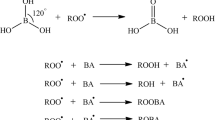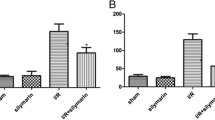Abstract
Acute kidney injury (AKI) is characterized by fast decline in renal function within a short period of time. Renal ischemic–reperfusion (I–R) injury is the main cause of AKI. This study aims to investigate the possible nephroprotective effect of lycopene on renal ischemic–reperfusion injury in mice model. Forty Swiss Albino adult male mice were randomly allocated onto one of the four study groups: sham group: mice had median laparotomy under anesthesia with no procedures performed, renal tissues and blood samples were collected. ischemic–reperfusion group (I–R-control): mice underwent median laparotomy under anesthesia, followed by 30 min bilateral renal ischemia. Renal tissues and blood samples were collected after 2 h from reperfusion. Vehicle-treated group: mice were pretreated with intra 1% dimethyl sulfoxide 30 min before inducing ischemia. Lycopene-treated group: mice were pretreated with 10 mg/kg intraperitoneal injection of lycopene 30 min before inducing renal ischemia. Renal tissues, and blood samples were collected after 2 h from reperfusion. Blood and tissue samples were collected to look for evidence of inflammation and necrosis. Blood urea nitrogen, serum creatinine as well as plasma NGAL levels were significantly increased in the active control group (P ≤ 0.05), when compared to the sham group. Similarly, renal levels of Notch2/Hes 1, TLR 2, IL-6, Bax, and F2-isoprostane were significantly increased in the active control group as compared to the sham group (P ≤ 0.05). Moreover, lycopene treatment was found to be significantly effective in reducing the increased levels of these markers after I–R injury (P ≤ 0.05).






Similar content being viewed by others
References
Ferenbach DA, Bonventre JV. Mechanisms of maladaptive repair after AKI leading to accelerated kidney ageing and CKD. Nat Rev Nephrol. 2015;11(5):264–76.
Chen L, Luodelete M, Dong C, Li B, Zhang W, Nie P, et al. Pathological spectrum of glomerular disease in patients with renal insufficiency: a single-center study in Northeastern China. Ren Fail. 2019;41(1):473–80.
Farrar CA, Keogh B, McCormack W, O’Shaughnessy A, Parker A, Reilly M, et al. Inhibition of TLR2 promotes graft function in a murine model of renal transplant ischemia-reperfusion injury. FASEB J. 2012;26(2):799–807.
Zhao H, Perez JS, Lu K, George AJ, Ma D. Role of Toll-like receptor-4 in renal graft ischemia-reperfusion injury. Am J Physiol Renal Physiol. 2014;306(8):F801–11.
Gupta VK, Siddiqi NJ, Ojha AK, Sharma B. Hepatoprotective effect of Aloe vera against cartap- and malathion-induced toxicity in Wistar rats. J Cell Physiol. 2019;234(10):18329–43.
Asanuma K, Oliva Trejo JA, Tanaka E. The role of Notch signaling in kidney podocytes. Clin Exp Nephrol. 2017;21(1):1–6.
Gupta VK, Singh R, Sharma B. Phytochemicals mediated signalling pathways and their implications in cancer chemotherapy: challenges and opportunities in phytochemicals based drug development: A review. Biochem Compd. 2017;5(1):2.
Richelle M, Lambelet P, Rytz A, Tavazzi I, Mermoud AF, Juhel C, et al. The proportion of lycopene isomers in human plasma is modulated by lycopene isomer profile in the meal but not by lycopene preparation. Br J Nutr. 2012;107(10):1482–8.
Agrawal A, Sharma B. Natural products and their antioxidant potential. Nat Prod. 2012;8(2):72–87.
Singh R, Sharma B. Certain traditional indian plants and their therapeutic applications: a review. VRI Phytomed. 2013;1(1):1–11.
Pereira BLB, Reis PP, Severino FE, Felix TF, Braz MG, Nogueira FR, et al. Tomato (Lycopersicon esculentum) or lycopene supplementation attenuates ventricular remodeling after myocardial infarction through different mechanistic pathways. J Nutrition Biochem. 2017;46:117–24.
Pisoschi AM, Pop A. The role of antioxidants in the chemistry of oxidative stress: a review. Eur J Med Chem. 2015;97:55–74.
Yu J, Gleize B, Zhang L, Caris-Veyrat C, Renard Cmgc. A D-optimal mixture design of tomato-based sauce formulations: effects of onion and EVOO on lycopene isomerization and bioaccessibility. Food Funct. 2019;10(6):3589–602.
Dodelet-Devillers A, Zullian C, Vachon P, Beaudry F. Assessment of stability of ketamine-xylazine preparations with or without acepromazine using high performance liquid chromatography-mass spectrometry. Can J Vet Res. 2016;80(1):86–9.
Wang L, Liu X, Chen H, Chen Z, Weng X, Qiu T, et al. Effect of picroside II on apoptosis induced by renal ischemia/reperfusion injury in rats. Exp Therap Med. 2015;9(3):817–22.
Skrypnyk NI, Harris RC, de Caestecker MP. Ischemia-reperfusion model of acute kidney injury and post injury fibrosis in mice. J Visual Exp JoVE. 2013;9(78):50495.
Salazar JH. Overview of Urea and Creatinine. Lab Med. 2014;45(1):e19–20.
Black CB, Duensing TD, Trinkle LS, Dunlay RT. Cell-based screening using high-throughput flow cytometry. Assay Drug Dev Technol. 2011;9(1):13–20.
Riser BL, Barreto FC, Rezg R, Valaitis PW, Cook CS, White JA, et al. Daily peritoneal administration of sodium pyrophosphate in a dialysis solution prevents the development of vascular calcification in a mouse model of uraemia. Nephrol Dial Transpl. 2011;26(10):3349–57.
Zhu Y, Yin X, Li J, Zhang L. Overexpression of microRNA-204-5p alleviates renal ischemia-reperfusion injury in mice through blockage of Fas/FasL pathway. Exp Cell Res. 2019;381(2):208–14.
Kaya C, Karabulut R, Turkyilmaz Z, Sonmez K, Kulduk G, Gulbahar O, et al. Lycopene has reduced renal damage histopathologically and biochemically in experimental renal ischemia-reperfusion injury. Ren Fail. 2015;37(8):1390–5.
Farag MM, Ahmed GO, Shehata RR, Kazem AH. Thymoquinone improves the kidney and liver changes induced by chronic cyclosporine A treatment and acute renal ischaemia/reperfusion in rats. J Pharm Pharmacol. 2015;67(5):731–9.
Jia Y, Zhao J, Liu M, Li B, Song Y, Li Y, et al. Brazilin exerts protective effects against renal ischemia-reperfusion injury by inhibiting the NF-κB signaling pathway. Int J Mol Med. 2016;38(1):210–6.
Su M, Ren S, Zhong W, Han X. Impact of propofol on renal ischemia/reperfusion endoplasmic reticulum stress. Acta Cirurgica Brasileira. 2017;32(7):533–9.
Sueud T, Hadi NR, Abdulameer R, Jamil DA, Al-Aubaidy HA. Assessing urinary levels of IL-18, NGAL and albumin creatinine ratio in patients with diabetic nephropathy. Diab Metabol Syndr Clin Res Rev. 2019;13(1):564–8.
Liu L, Pang XL, Shang WJ, Xie HC, Wang JX, Feng GW. Over-expressed microRNA-181a reduces glomerular sclerosis and renal tubular epithelial injury in rats with chronic kidney disease via down-regulation of the TLR/NF-kappaB pathway by binding to CRY1. Mol Med. 2018;24(1):49.
Zhou JQ, Qiu T, Zhang L, Chen ZB, Wang ZS, Ma XX, et al. Allopurinol preconditioning attenuates renal ischemia/reperfusion injury by inhibiting HMGB1 expression in a rat model. Acta Cirurgica Brasileira. 2016;31(3):176–82.
Fang DY, Lu B, Hayward S, de Kretser DM, Cowan PJ, Dwyer KM. The role of activin A and B and the benefit of follistatin treatment in renal ischemia-reperfusion injury in mice. Transpl Direct. 2016;2(7):e87.
Maschirow L, Khalaf K, Al-Aubaidy HA, Jelinek HF. Inflammation, coagulation, endothelial dysfunction and oxidative stress in prediabetes Biomarkers as a possible tool for early disease detection for rural screening. Clin Biochem. 2015;48(9):581–5.
Liu M, Wang H, Zhang J, Yang X, Li B, Wu C, et al. NF-kappaB signaling pathway-enhanced complement activation mediates renal injury in trichloroethylene-sensitized mice. J Immunotoxicol. 2018;15(1):63–72.
Acknowledgements
We acknowledge the support of technical staff at Department of Pharmacology and Therapeutics, Faculty of Medicine, University of Kufa.
Funding
This work received no external funds.
Author information
Authors and Affiliations
Corresponding author
Ethics declarations
Conflict of interest
The authors declare that they have no potential conflict of interest.
Additional information
Publisher's Note
Springer Nature remains neutral with regard to jurisdictional claims in published maps and institutional affiliations.
Rights and permissions
About this article
Cite this article
Hussien, Y.A., Abdalkadim, H., Mahbuba, W. et al. The Nephroprotective Effect of Lycopene on Renal Ischemic Reperfusion Injury: A Mouse Model. Ind J Clin Biochem 35, 474–481 (2020). https://doi.org/10.1007/s12291-019-00848-7
Received:
Accepted:
Published:
Issue Date:
DOI: https://doi.org/10.1007/s12291-019-00848-7




